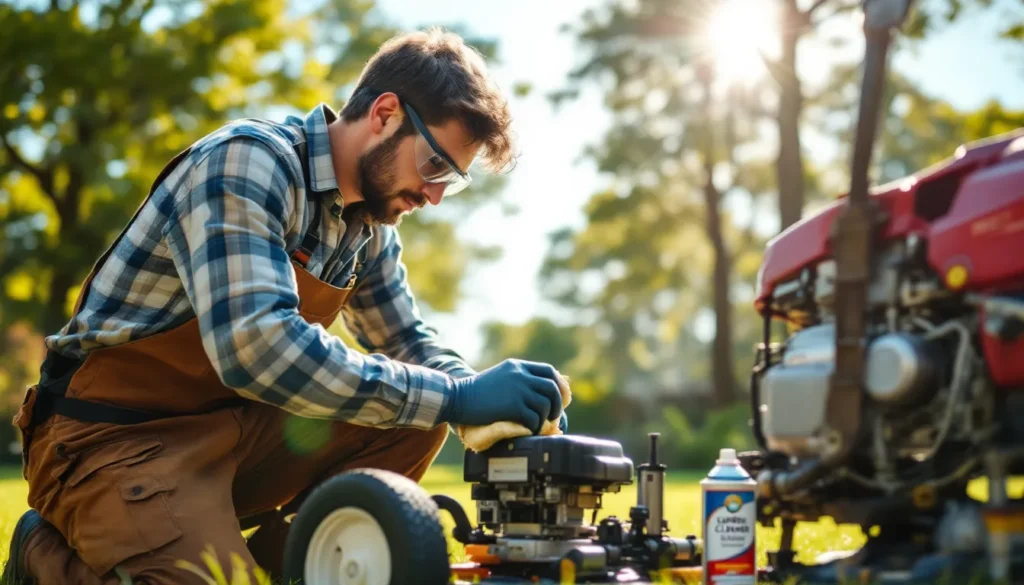Your lawn mower’s carburetor plays a crucial role in keeping your machine running smoothly. Over time, dirt and debris can accumulate, leading to poor performance and frustrating starts. Cleaning the carburetor not only enhances efficiency but also extends the life of your mower.
Whether you’re a seasoned DIYer or a beginner, tackling this task can save you money and ensure your mower is ready for the next mowing season. In just a few simple steps, you can restore your carburetor to peak condition, making your lawn care routine more enjoyable and hassle-free. Let’s dive into how you can easily clean your lawn mower’s carburetor and get back to maintaining that perfect lawn.
Importance Of Cleaning Lawn Mower Carburetor
Cleaning the lawn mower carburetor plays a crucial role in maintaining your mower’s overall efficiency. A clean carburetor ensures proper fuel mixture, which optimizes combustion and enhances engine performance.
Dirt and debris accumulation can block fuel passages, leading to inefficient fuel delivery. This blockage results in rough running, stalling, or even no-start conditions. Regular carburetor cleaning prevents these issues, ensuring smoother operation.
Additionally, a clean carburetor contributes to fuel efficiency. When the air-fuel mixture is balanced, the engine burns fuel more effectively, resulting in lower consumption. This efficiency saves you money over time on fuel costs.
Cleaning the carburetor also extends your mower’s lifespan. Neglecting this maintenance task can lead to further engine damage, resulting in costly repairs or replacements. Regular attention to the carburetor helps keep your mower in top condition for years.
Ultimately, routine carburetor cleaning enhances the enjoyment of lawn care, providing reliability and ease of use.
Tools And Supplies Needed

Cleaning a lawn mower carburetor requires specific tools and supplies for effective maintenance. Below is a list of essential items you’ll need for this task.
Essential Tools
- Screwdrivers: Use both flathead and Phillips screwdrivers for removing carburetor components.
- Wrenches: A set of wrenches, including adjustable ones, helps in unscrewing nuts and bolts.
- Pliers: Needle-nose pliers work well for grasping small parts and tight spaces.
- Socket Set: A socket set enables efficient removal of various fasteners.
- Cleaning Brushes: A small brush, like a toothbrush, assists in dislodging dirt and debris.
- Rag or Cloth: A clean rag helps wipe surfaces and remove excess cleaning solution.
- Safety Goggles: Protect your eyes from chemicals and debris during the cleaning process.
Cleaning Solutions
- Carburetor Cleaner: A dedicated carburetor cleaner effectively removes varnish and gum build-up.
- Gasoline: Regular gasoline can serve as a cleaning solvent for parts that require rinsing.
- Soapy Water: A mixture of dish soap and water works for gentle cleaning of metal components.
- Compressed Air: Use compressed air to blow out small passages and remove stubborn dirt.
- Brake Cleaner: A non-chlorinated brake cleaner can help dissolve grease and grime.
Gathering these tools and solutions ensures a thorough and efficient cleaning process for your lawn mower’s carburetor.
Step-By-Step Guide
Follow these steps to effectively clean your lawn mower’s carburetor, ensuring optimal performance and longevity.
Preparing The Lawn Mower
- Disconnect the spark plug – Prevent accidental starts by removing the spark plug wire.
- Drain the fuel – Use a siphon or run the mower until it runs out of fuel to avoid spills.
- Gather your tools – Ensure you have screwdrivers, wrenches, pliers, a rag, and safety goggles ready for the task.
Removing The Carburetor
- Locate the carburetor – Identify its position, typically near the engine, connected to the air filter.
- Remove the air filter – Unscrew or unclip the filter housing to access the carburetor.
- Disconnect the linkages – Detach throttle and choke cables by unscrewing or unclipping them as necessary.
- Unscrew the carburetor – Remove the bolts securing the carburetor to the engine and lift it off gently.
Cleaning The Carburetor
- Disassemble components – Take apart the carburetor by removing the float bowl and other removable parts.
- Use carburetor cleaner – Spray the interior and parts, focusing on jets and openings. Allow it to sit for a few minutes.
- Scrub stubborn areas – Use a cleaning brush on difficult spots, ensuring all deposits and residue are gone.
- Rinse – Clean with compressed air to remove excess cleaner and dislodged debris, ensuring all passages are clear.
Reassembling The Lawn Mower
- Reattach the carburetor – Position it back on the engine and secure it with bolts.
- Reconnect linkages – Ensure throttle and choke cables are properly attached and functioning.
- Replace the air filter – Reinsert the filter and secure the housing.
- Reconnect the spark plug – Attach the spark plug wire, completing the reassembly process.
Following these steps ensures a clean carburetor, leading to improved mower performance.
Maintenance Tips To Prevent Clogs
Preventing clogs in your lawn mower carburetor requires consistent maintenance. Implement these tips to keep your carburetor functioning smoothly:
- Use fresh fuel: Fresh fuel contains stabilizers that prevent degradation. Store fuel properly and apply it within 30 days to minimize the risk of clogs.
- Add fuel stabilizers: Fuel stabilizers enhance shelf life. Use them in your fuel to reduce the likelihood of varnish and sediment buildup in the carburetor.
- Clean fuel filter: Inspect and clean the fuel filter regularly. A clogged filter restricts fuel flow, leading to carburetor issues.
- Drain fuel for storage: Before winter or extended storage, drain the fuel tank and carburetor. This prevents old fuel from gumming up the carburetor passages.
- Check air filter: Replace or clean the air filter frequently. A clean air filter prevents dirt and debris from entering the carburetor, reducing clogging potential.
- Inspect gaskets and seals: Examine carburetor gaskets and seals for wear. Damaged gaskets allow dirt to enter the carburetor, leading to clogs.
- Regular operation: Operate your lawn mower regularly. Regular use prevents fuel from stagnating and minimizes the risk of deposits forming in the carburetor.
- Schedule routine maintenance: Follow a regular maintenance schedule. Regular inspections and cleanings keep your mower in optimal condition and help prevent carburetor issues.
Conclusion
Cleaning your lawn mower’s carburetor is a straightforward yet vital task for maintaining its performance. By taking the time to do this, you can enhance your mower’s efficiency and ensure it runs smoothly for years to come. Regular maintenance not only saves you money on fuel but also prevents costly repairs down the line.
Remember to use fresh fuel and check your filters regularly to avoid future clogs. With these simple steps, you’ll enjoy a well-functioning mower that makes lawn care a breeze. Keep your mower in top shape and watch your yard thrive.

Hi, I’m Md Rofiqul, a gardening enthusiast who loves spending time in the garden and backyard. I enjoy caring for plants, growing flowers and vegetables, and creating a green space that feels peaceful and refreshing. Gardening is more than just a hobby, it’s a passion that connects me to nature and brings joy to my daily life. Living with plants inspires me to embrace simplicity, patience, and sustainability while making every day more colorful and rewarding.
